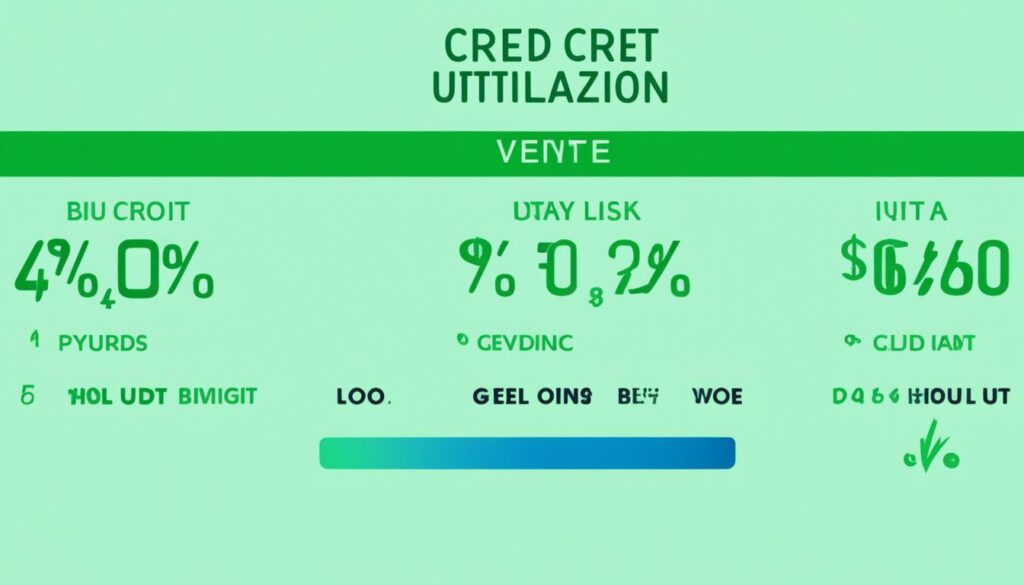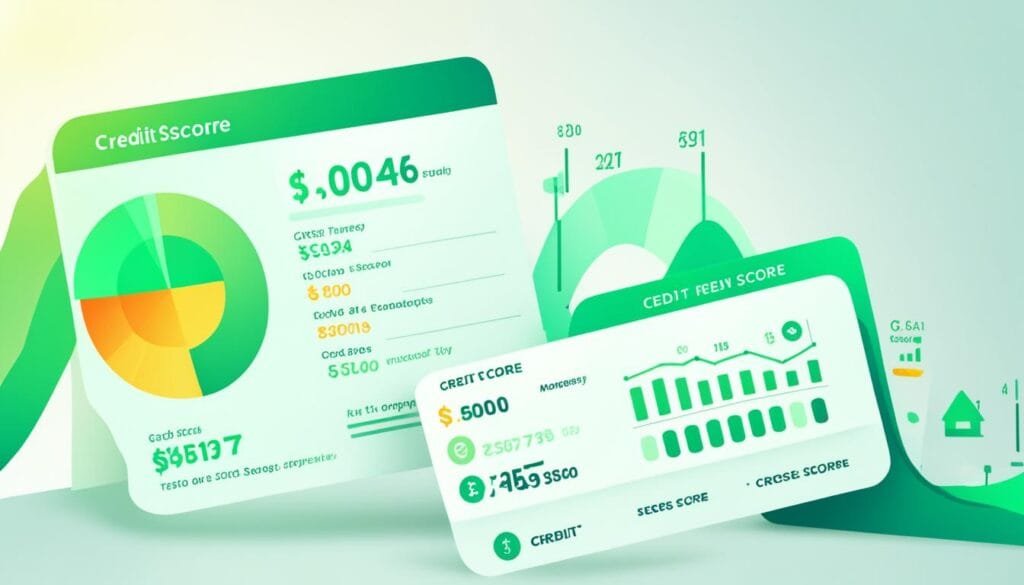Your credit utilization ratio is an essential factor when it comes to calculating your credit scores. It reflects the amount of revolving credit you are using compared to the total credit available. Lenders rely on your credit utilization ratio to evaluate how responsibly you manage your debts. Generally, a lower credit utilization ratio is more favorable for your credit scores.
Key Takeaways:
- Your credit utilization ratio is the ratio of your total credit usage to the total credit available to you.
- Lenders prefer a credit utilization ratio of no more than 30% as it indicates responsible debt management.
- To calculate your credit utilization ratio, add up the balances on all your revolving credit accounts and divide it by the total credit limits.
- Your credit utilization ratio plays a significant role in determining your credit scores, second only to payment history.
- By reducing outstanding debt and responsibly using credit, you can improve your credit utilization ratio and enhance your credit profile.
What is a credit utilization ratio?
Your credit utilization ratio, expressed as a percentage, is the amount of revolving credit you’re using divided by the total credit available to you. Revolving accounts, such as credit cards and home equity lines of credit (HELOCs), provide a steady source of credit that can be used repeatedly.
Lenders prefer a credit utilization ratio of no more than 30% as it shows responsible debt management. By keeping your credit utilization within this range, you demonstrate that you’re not relying too heavily on credit and have a good balance between the credit you’re using and the credit you have available.
Revolving credit, like credit cards and HELOCs, allows you to borrow and repay funds flexibly. Unlike installment loans, where you borrow a fixed amount and make fixed payments, revolving credit gives you a credit limit that you can draw from as needed. As you repay the borrowed amount, your credit becomes available again, providing you with a revolving source of credit.
It’s important to note that a credit utilization ratio applies specifically to revolving credit, not to other types of loans like mortgages or car loans. These types of loans have a fixed amount and are not considered in the credit utilization ratio calculation.
“Your credit utilization ratio is an essential factor that lenders consider when evaluating your creditworthiness. It provides them with insights into how responsibly you manage and use your available credit.”
The Impact of Credit Utilization Ratio
A lower credit utilization ratio signifies that you are managing your revolving credit responsibly and not relying on credit too heavily. This demonstrates to lenders that you have a lower risk of defaulting on your debts and are likely to be more trustworthy in repaying borrowed funds.
High credit utilization ratios, on the other hand, indicate that you may be relying too heavily on credit and could potentially be at risk of overextending yourself financially. This can raise concerns for lenders as it suggests a higher risk of defaulting on payments and may negatively impact your creditworthiness.
Having a high credit utilization ratio can also limit your financial flexibility. If you’re close to maxing out your available credit, it may be challenging to respond to unexpected expenses or take advantage of new credit opportunities. Keeping your credit utilization ratio low can provide you with greater financial freedom and more favorable lending terms in the future.
Calculating Your Credit Utilization Ratio
To calculate your credit utilization ratio, you need to divide the total credit you’re using by your total available credit.
Credit Utilization Ratio = (Total Credit Used / Total Available Credit) x 100
For example, if you have a credit card with a limit of $5,000 and you have a balance of $1,500, your credit utilization ratio would be:
(1,500 / 5,000) x 100 = 30%
This example shows that you are using 30% of your available credit, which falls within the recommended range for responsible credit management.
Managing Your Credit Utilization Ratio
Maintaining a healthy credit utilization ratio is crucial for managing your credit effectively. Here are a few strategies to help you keep your credit utilization ratio in check:
- Pay your credit card balances in full and on time each month to minimize the amount of credit you’re using.
- Avoid maxing out your credit cards or exceeding your credit limits.
- If possible, pay more than the minimum payment due to reduce your outstanding credit card balances faster.
- Consider increasing your credit limits to create a buffer between your credit usage and available credit.
- Avoid opening too many new credit accounts within a short period as this can negatively impact your credit scores.
By effectively managing your credit utilization ratio, you can demonstrate responsible credit usage and maintain a healthy credit profile.
How to calculate your credit utilization ratio
Calculating your credit utilization ratio is an essential step in understanding your overall credit health. This ratio measures the percentage of your available credit that you are currently using. By knowing your credit utilization ratio, you can gauge how effectively you are managing your debts and take steps to improve it if necessary.
To calculate your credit utilization ratio, follow these simple steps:
- Add up the balances on all your revolving credit accounts. This includes credit cards, store cards, and any other lines of credit that allow you to borrow repeatedly.
- Next, determine the total credit limit across all these accounts. This represents the maximum amount of credit available to you.
- Divide the total balance by the total credit limit.
- Finally, multiply the result by 100 to convert it into a percentage.
Let’s illustrate this calculation with an example:
| Revolving Credit Accounts | Balance | Credit Limit |
|---|---|---|
| Credit Card 1 | $450 | $1,000 |
| Credit Card 2 | $300 | $2,000 |
In this scenario, the total outstanding debt across the two credit cards is $750, and the total credit available is $3,000. To calculate the credit utilization ratio:
Credit Utilization Ratio = (Total Outstanding Debt / Total Credit Available) x 100
= ($750 / $3,000) x 100
= 0.25 x 100
= 25%

By regularly calculating your credit utilization ratio, you can monitor your debt management and make informed decisions to improve your credit health. Keep in mind that a lower credit utilization ratio is generally favorable, as it indicates responsible credit usage and can positively impact your credit scores.
How your credit utilization ratio affects your credit scores
Your credit utilization ratio is a key factor that lenders use to assess your creditworthiness and determine your credit scores. It measures the amount of credit you’re using relative to your total available credit. Understanding how this ratio impacts your credit scores is essential for maintaining a healthy credit profile.
When calculating your credit scores, lenders consider various factors such as payment history, length of credit history, types of credit used, and new credit. However, your credit utilization ratio holds significant weight and is often the second most influential factor after payment history.
A low credit utilization ratio indicates responsible credit usage and demonstrates to lenders that you’re effectively managing your debt. It shows that you’re not relying heavily on credit and have a good handle on your financial obligations.
On the other hand, a high credit utilization ratio can negatively impact your credit scores. It suggests that you may be using a substantial portion of your available credit, which can be viewed as an increased risk by lenders. This could result in lower credit scores and potentially affect your ability to qualify for favorable loan terms and interest rates.
To illustrate the impact of credit utilization on credit scores, let’s consider an example:
| Credit Utilization Ratio | Credit Scores |
|---|---|
| Less than 30% | Excellent – Very Good |
| 31% – 49% | Good – Fair |
| 50% or higher | Poor – Very Poor |
This table clearly shows how different ranges of credit utilization ratios correspond to different credit score ranges. Maintaining a credit utilization ratio below 30% is generally considered ideal for achieving excellent or very good credit scores.
In conclusion, your credit utilization ratio is a crucial factor in determining your credit scores. Keeping your credit utilization low by using credit responsibly and keeping balances in check can help you maintain and improve your credit scores. Make regular payments, avoid maxing out your credit cards, and strive to keep your credit utilization ratio as low as possible to demonstrate your creditworthiness to lenders and secure better financial opportunities.
How to maintain a good credit utilization ratio
To maintain a good credit utilization ratio, it’s essential to take proactive steps to improve your financial standing. By following these strategies, you can minimize your outstanding debt, increase your credit limits, and ultimately achieve a healthier credit utilization ratio.
Decrease Outstanding Debt
To improve your credit utilization ratio, focus on reducing your outstanding debt. Making regular payments towards your credit card balances and other revolving credit accounts is key. Consider creating a monthly budget to allocate funds specifically for debt repayment. By consistently chipping away at your debt, you’ll gradually decrease your outstanding balances and improve your credit utilization ratio.
Increase Credit Limits
An effective way to improve your credit utilization ratio is to increase your credit limits. This can be accomplished in two main ways:
- Request a Credit Limit Increase: Contact your current credit card issuer and inquire about the possibility of increasing your credit limit. Highlight your responsible credit usage and prompt payment history. Remember that this process may involve a credit inquiry, which can temporarily impact your credit scores. However, obtaining a higher credit limit can significantly improve your credit utilization ratio.
- Apply for a New Credit Card: If increasing your credit limits with your current credit card issuer is not an option, you can apply for a new credit card. Choose a credit card that offers higher credit limits and aligns with your financial needs. However, use this option cautiously and ensure that you do not accumulate more debt as a result.
By increasing your credit limits, you expand the available credit at your disposal. This, in turn, reduces your credit utilization ratio and positively impacts your credit scores.
| Outstanding Debt | Credit Limit | Credit Utilization Ratio |
|---|---|---|
| $5,000 | $10,000 | 50% |
| $3,000 | $10,000 | 30% |
| $2,000 | $5,000 | 40% |
“Increasing your credit limits can help you maintain a healthy credit utilization ratio. By having a higher credit limit, you have more available credit, allowing for a lower utilization percentage. Just be sure not to abuse the increased credit and accumulate more debt.”
By implementing these strategies, you can maintain a good credit utilization ratio, which is crucial for a healthy credit profile. Regularly monitor your outstanding debt and credit limits, making adjustments as needed to stay on track and improve your credit scores.

How Does Understanding Credit Score Calculators Tie into Your Credit Utilization Ratio?
Understanding credit score calculators is crucial in managing your credit utilization ratio. These calculators help you comprehend how your credit usage affects your score. By using these tools, you can make strategic decisions to keep your credit utilization low, ultimately improving your overall credit score.
Conclusion
Understanding and effectively managing your credit utilization ratio is essential for maintaining a healthy credit profile. By keeping your credit utilization ratio low, you can positively impact your credit scores and enhance your creditworthiness. This, in turn, opens doors to better credit opportunities and favorable terms.
To improve your credit utilization ratio, focus on reducing your outstanding debt and utilizing credit responsibly. Make regular payments to decrease your debt and consider creating a budget to allocate funds towards debt repayment. Additionally, increasing your credit limits can help improve your ratio. Request a credit limit increase from your current credit card issuer or apply for a new credit card, but be cautious not to accumulate more debt.
Regularly monitoring your credit utilization ratio is crucial to maintaining a good credit standing. Keep track of your balances and credit limits to ensure you stay within the recommended threshold. By actively managing your credit utilization ratio, you can work towards achieving an optimal credit profile and better financial opportunities.
FAQ
What is a credit utilization ratio?
Your credit utilization ratio is a factor in calculating your credit scores. It represents the amount of revolving credit you’re using divided by the total credit available to you. Lenders use your credit utilization ratio to evaluate how well you’re managing your debts. A lower credit utilization ratio is generally better for your credit scores.
How to calculate your credit utilization ratio?
To calculate your credit utilization ratio, add up the balances on all your revolving credit accounts and divide it by the total credit limits of those accounts. Convert the result to a percentage. For example, if you have two credit cards with balances of $450 and $300 and credit limits of $1,000 and $2,000 respectively, your total outstanding debt is $750 and your total available credit is $3,000, resulting in a credit utilization ratio of 25%.
How does your credit utilization ratio affect your credit scores?
Your credit utilization ratio plays a significant role in calculating your credit scores. It is often the second most important factor, following payment history. Lenders use it to assess your debt management skills and predict your ability to repay borrowed funds. A low credit utilization ratio indicates responsible credit usage and can have a positive impact on your credit scores.
How can I maintain a good credit utilization ratio?
To maintain a good credit utilization ratio, it’s best to decrease your outstanding debt by making regular payments. Consider creating a monthly budget to allocate funds for debt repayment. Additionally, you can improve your ratio by increasing your credit limits. This can be done by requesting a credit limit increase from your current credit card issuer or applying for a new credit card. However, be cautious not to overspend and accumulate more debt.
Any tips for improving my credit utilization ratio?
Understanding and managing your credit utilization ratio is crucial for maintaining a healthy credit profile. By reducing outstanding debt and responsibly using credit, you can improve your credit utilization ratio and work towards achieving an optimal credit profile. Remember to regularly monitor your credit utilization ratio and make necessary adjustments to maintain a good credit standing.

